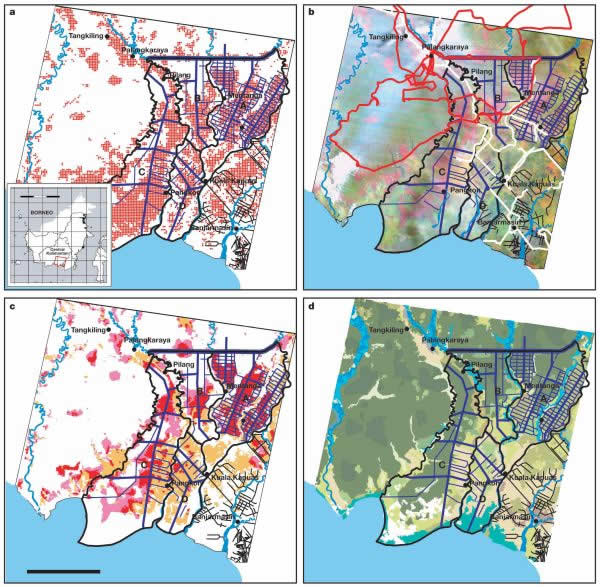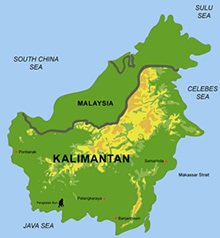remote sensing

our work
kalteng remote sensing shows trends in environments like Kalimantan.
- TanDEM-X elevation model data for canopy height ...
- Monitoring Forest Threats with C- and L-band SAR, ...
- Ground Penetrating Radar Mapping of Peat ...
- Spectral Variability and Discrimination ...
- Kalteng Consultants Company Profile, Oct
- Visiting of Wetlands International Camp on ...
- Ortho Photo Mosaik von Kelurahan Tumbang Tahai ...
- Ortho-Photo Mosaik from Lake Batu, north of ...
- International Symposium & Workshop on Tropical ...
- The Contribution of CHRIS/PROBA Data for Tropical ...
- Workshop on Spatial Planning and new Remote ...
- Ortho-Photo Generation and Mosaiking of City ...
- Ortho-Photo Mosaik from Kecamatan Bukit Batu, ...
- International Workshop, Wild Fire and Carbon ...
- Planning Group for Kecamatan Bukit Batu gathered ...
- Carbon Storage in the Northern Sabangau Area ...
- Peat Land Topography derived from 30m Resolution ...
- Peat depth, minerals below peat, carbon, fires ...
- Carbon Storage in the Northern Sebangau Area ...
- Peatland Topography DEM-measurements with ...
- Precise Measurements of Peatland Topography and ...
- Environmental Management Study of the Tangkiling ...
- Environmental Field Trials and GIS Image ...
- Land Cover Change on Peatland in Kalimantan ...
- The Impact of Logging and Land Use Change in ...
- Tracks along the Kalimantan Highway from Kasongan ...
- Fires in 2002 monitored on the Landsat-images 14 ...
- The Amount of Carbon released from Peat and ...
- Land use Change in Central Kalimantan over the ...
- Remote Sensing and Aerial Survey of Vegetation ...
- Monitoring land cover and impacts, Remote Sensing ...
- Fire Impacts and Carbon Release on Tropical ...
- Ecological Impact of the one Million Hectare Rice ...
- Land Use Change and (Il)-Legal Logging in Central ...
- Peat fires in Central Kalimantan, Indonesia: Fire ...
- Environmental Helicopter Flight Trails with ...
- Impact of the 1997 Fires on the Peatlands of ...
- Application of Remote Sensing and GIS to monitor ...
- Monitoring of 1997/1998 Fires and Burnt Scars in ...
- Flight survey over the Mega Rice Project and over ...
- Application of Remote Sensing and GIS to survey ...
- Mega Rice Project in Central Kalimantan, ...
- Satellite Images and Aerial Photos from the ...
- The need for better
- Remote Sensing Verification by Aerial Surveys and ...
- NATURAL RESOURCE FUNCTIONS, BIODIVERSITY AND ...
- Excursion to Central Kalimantan, ...
- Satellite Images and Aerial Photography’s from ...
- Symposium of International Peat Society, ...
- Indonesia Travel to Jakarta, Bali and Kalimantan ...
- The Mega Rice Project Central Kalimantan ...
- Land Use Planning and Environmental Monitoring in ...
- Bildverarbeitung von Sensorbildern zur Erstellung ...
- GIS-Workshop, Camp km48 Sangai.
- Monitoring Land Use Change on Tropical Peatland ...
- Seminar on Scientific Implications of the ...
- Report of Ground Truth Campaigns incl. Aerial ...
- Ground and Helicopter verification of Satellite ...
- Environmental Detection from Satellite and ...
- First visit to Central Kalimantan in June 1995, ...
- Environmental Helicopter with Modular Sensor ...
- Remote Sensing with a Thermal Imager on an ...
- The Use of an Environmental Helicopter for the ...
- EUROMAR-SEASTARS a Modular Multi-Sensor System ...
gallery

image gallery
Find a large collection of images from many years of exploration by kalteng-consultants.
History Borneo - Kalimantan · Excursions to peatland 1996 · Mega Rice Project 1999 · 2004 · 2005 · 2006 · 2007 · 2008 · 2009 · 2010 · 2011 · 2012 · 2013 · 2014 · 2015 · 2016-March · 2016-August ·
remote sensing
The Amount of Carbon released from Peat and Forest Fires in Indonesia during 1997, Nature, Vol. 7th Nov. 2002
* Department of Geography, University of Leicester, Leicester LE1 7RH, UK
† Ludwigs-Maximilians-Universita¨t Mu¨nchen, Biology Department II,
Luisenstrasse 14, D-80333 Mu¨nchen, Germany, and Remote Sensing Solutions GmbH, Woerthstrasse 49, D-81667 München, Germany
‡ Kalteng Consultants, Kirchstockacher Weg, 81663 München, Germany
§ School of Geography, University of Nottingham, Nottingham NG7 2RD, UK
k Centre for International Co-operation in Management of Tropical Peatland, Faculty of Agriculture, University of Palangka Raya, Palangka Raya 73112, Indonesia

............................................................................................................................................................................
Press release
Professor Jack Rieley of the School of Geography, University of Nottingham, Dr. Susan Page of the Department of Geography, University of Leicester and Dr. Viktor Boehm of Kalteng Consultants announce a breakthrough article in the latest issue of the internationally renowned scientific journal Nature. Professor Rieley, Dr. Page and Dr. Boehm, together with a team of European and Indonesian scientists present new insights into the effects of tropical forest fires on global climate. The scientists used a combination of satellite-based earth observations and intensive field data collection to estimate the amount of the greenhouse gas CO2 released by fires in the forested and deforested peatlands of Indonesia.
This retrospective study evaluated the impact of the 1997/1998 El Niño driven fire disaster. During that time forest and peatland fires destroyed huge areas of rainforest in Southeast Asia, especially in Indonesia. It was the biggest fire catastrophe ever observed in that region. A noxious, yellow cloud of haze extending 3000 x 5000 kilometres covered the region for several months, affecting Indonesia, and neighbouring countries of Singapore, Malaysia, Brunei and Thailand. The economic damage resulting from the smoke alone was estimated to exceed two billion US dollars, closing airports, schools and offices and disrupting trade. The polluting ‘haze’ also had a serious impact on human health by increasing respiratory problems affecting, especially, the young and elderly.
For their studies, the scientists focused on tropical peat swamp forest, a largely unknown ecosystem that occurs on organic soil deposits that can exceed 12 metres in thickness. Owing to the high carbon content of this organic material, surface fires spread underground into the peat layer. These fires are characterised by incomplete burning and produce huge amounts of smoke, fine-particle ‘haze’ and chemical pollutants. Peat swamp forests represent approximately 40 per cent of the land area in Indonesia that burned during the 1997/1998 fires. The amount of carbon released during that time was the biggest ever detected and, at 0.81-2.57 Billion tonnes, corresponds to 13 to 40 percent of the annual global carbon production by burning fossil fuels, such as oil, coal and gas.
The work by Professor Rieley, Dr. Page and Dr. Boehm and their colleagues highlights the fact that tropical peat stores huge amounts of carbon that will continue to be released to the atmosphere as carbon dioxide during future forest fires and land conversion from forest to agriculture. Carbon dioxide is known to play a major role in the global warming of the atmosphere of the earth. Recurrent fires have, therefore, the threatening potential of making a very significant contribution to climate change, particularly during El Niño weather events that, in Indonesia, lead to a reduction in precipitation and drought conditions during the extended dry season that results.
Professor Rieley, Dr. Page and Dr. Boehm said: “The data presented in Nature for what happened in the 1997 disaster are very relevant at the present time because the peatlands of Indonesia have been burning again with great ferocity, generating more choking haze, during this year’s extended dry season, caused by a weak El Niño. Once again these fires have been started by people for land clearance but also for sheer amusement and vandalism. The haze has been denser for longer periods than in 1997 and has had a worse effect upon human health. Palangka Raya airport was closed for almost two months and the economic and social life of Central Kalimantan Province came to a virtual standstill. Hospitals became full and many people left for elsewhere in Indonesia. The main source of the polluting haze are the fires inside the peat soil that smoulder for a long time after surface fires have extinguished and re-ignite in the slightest breeze causing further fires on the surface. The combination of drought and poor land management, in particular excessive logging and drainage of the peat swamps, have made this ecosystem very susceptible to fire, which will reoccur frequently in the future unless drastic mitigation measure are undertaken”.
Unless land use policies are changed to control land clearance by fire, then recurrent fires will lead to a complete loss of Borneo’s peat swamp forests within a few decades with continued, high emissions of carbon dioxide to the atmosphere. The scientists are demanding intensive national and international efforts to avoid further fires in the tropical peat swamp forests and to promote environmentally sustainable management of this sensitive ecosystem. They ask politicians and international aid donors to act now.

